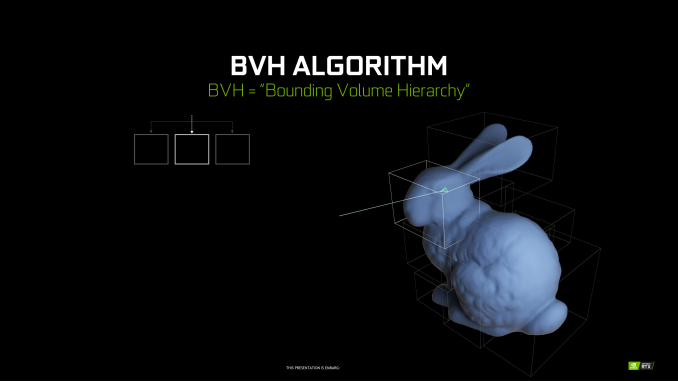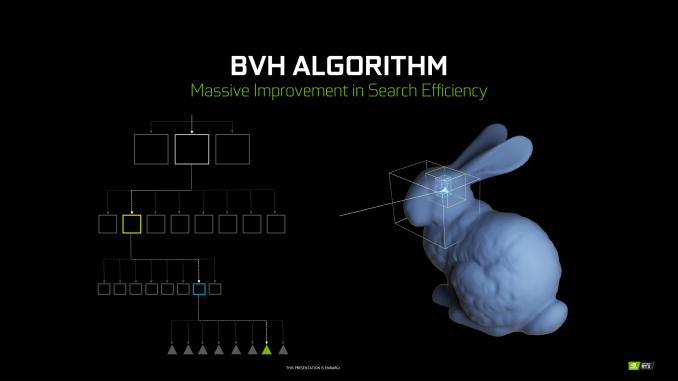The NVIDIA Turing GPU Architecture Deep Dive: Prelude to GeForce RTX
by Nate Oh on September 14, 2018 12:30 PM ESTBounding Volume Hierarchy - How Computers Test the World
Perhaps the biggest aspect of NVIDIA’s gamble on ray tracing is that traditional GPUs just aren’t very good at the task. They’re fast at rasterization and they’re even fast at parallel computing, however ray tracing does not map very well to either of those computing paradigms. Instead NVIDIA has to add hardware dedicated to ray tracing, which means devoting die space and power to hardware that cannot help with traditional rasterization.
A big part of that hardware, in turn, will go into solving the most basic problem of ray tracing: how do you figure out what a ray is intersecting with? The most common solution to this problem is to store triangles in a data structure that is well-suited for ray tracing. And this data structure is called a Bounding Volume Hierarchy.
Conceptually, a BVH is relatively simple – at least for the purposes of this article. Rather than testing every polygon to see if a ray interacts with it, the idea is to test a portion of a scene to see if it interacts with a ray, and then keep drilling down. If there is an intersection with that portion of the scene, then subdivide it into smaller portions and test again. And again. And again. All the way until you reach the individual polygon, at which point the ray testing is resolved.
For the computer scientists in the crowd, this might sound a lot like an application of a binary search, and it is. Each test allows for a significant number of options (in this case polygons) to be discarded as possible answers. This gets to the right polygon in just a fraction of the time. A BVH, in turn, is stored in what’s essentially a tree data structure, with each subdivision – called bounding boxes – stored as children of their parent bounding box.
Now the catch with BVH is that while it radically cuts down on the amount of ray intersection needed compared to a naïve implementation, it’s still not super cheap. A number of tests are still required for each ray, with both successful and failed tests adding to the total number of tests taken. And all of this is for a single ray, when a significant number of rays are going to be needed for each pixel. Which is why hardware acceleration of the process is so important (and not at all easy).
The other major computational cost here is that BVHs themselves aren’t free. One needs to be created for a scene from the polygons in it, so there is an additional step before ray casting can even begin. This is more a developer concern – when can they modify and reuse a BVH versus building a new one – but it’s another step in the process. Furthermore it’s an example of why developer training and efficient engine implementations are so crucial to the process, as a poor implementation can make ray tracing much too slow to be viable.













111 Comments
View All Comments
Tamz_msc - Saturday, September 15, 2018 - link
"Besides, what you said isn't true even limiting the discussion to what was covered in this article. The Turing Tensor cores allow for a greater range of precisions."You mean lower precision, right? INT8 and INT4 are lower range. From a higher-level view Volta is very similar to Turing, just like the OP described.
Yojimbo - Saturday, September 15, 2018 - link
"greater range of precisions"INT8, INT4, FP16, etc., are precisions. The range of precisions an architecture can handle is the set of all precisions it can handle. Turing Tensor Cores can handle INT4, INT8, and FP16, whereas Volta Tensor Cores can handle FP16. So Turing can handle a greater range of precisions.
Bulat Ziganshin - Friday, September 14, 2018 - link
I would pray for 2060 w/o all this RT/FP16 stuffSpunjji - Monday, September 17, 2018 - link
Seems likely given how nutso these die sizes are. I expect we won't see it until after Pascal inventory is cleared, though.Da W - Friday, September 14, 2018 - link
Well still playing on my 3-screen Haswell + GTX780 rig, and being pretty satisfied of it, i'll probably just get a cheap GTX 1070 or 1080 for my new Ryzen rig and wait if ray tracing really gets adopted in 1 or 2 years. Seems to me lots of transistors invested for not many games. If history told us anything, it's not because a technology is great that it will get adopted, especially if it asks LOADS more developper time for the game companies.Not sure AMD won't come up with something either down the line. They've been given for dead for over 2 decades, guess where they are now!
Holliday75 - Monday, September 17, 2018 - link
I am waiting as well. This is the first attempt to change the game. Next gen or two is where it will be fined tuned and worth purchasing. This feels like a 4k TV purchase. Waste of money.abufrejoval - Friday, September 14, 2018 - link
I wonder how much Turing is about staking out territorial claims vs. dark silicon also coming to GPUs...Obviously Nvidia wants to protect its CUDA machine learning and HPC empire against custom ASIC competitors which finally also include Intel with their Configurable Spatial Accellerator, as well as Cambricon, Google's TPU ASICs and far too many others for comfort.
But while many seem to bemoan that tensor core or rasterizing real-estate is a waste for gaming and just about raising the purchase prices with overhyped features nobody needs, I wonder if apart from the partial truth in that the other motivating driver is simply that the inability to translate additional transistors into additional performance as additional bandwidth requires step changes in GDDR6 lanes (with unshrinkable pad areas and amplifiers) and hits foundry reticle sizes.
So they had transistors left over (wonder where those came from without a die shrink: I/O voltage reduction, layout optimizations, really bigger chips?), that could not be turned into direct DX1x performance gains due to bandwidth and TDP constraints and going to a richer functional base with Tensor Cores and raytrace assists would eat alternate bandwidth or TDP budgets, not additional ones.
Any truth in those assumptions?
abufrejoval - Friday, September 14, 2018 - link
ok, much bigger chips...And no rip-off: They are worth what they are charging if only for the inference accelleration.
Yojimbo - Saturday, September 15, 2018 - link
I am not convinced the Tensor Cores take up a lot of real estate. And they are tightly integrated into NVIDIA's SMs. Designing two SMs, one with Tensor Cores and one without Tensor Cores would be a lot more expensive than leaving them in. Plus, NVIDIA sees deep learning as important for gaming.Your argument about FLOPS per bandwidth does have validity. It's just that neither Tensor Cores nor RT cores were just thrown in there because they had transistors left over. Look at the die sizes of these new GPUs compared to Pascal GPUs. If they built a smaller chip that performed the same in legacy games then they could sell them more cheaply, and so sell more of them, while making the same profit on each one. That would mean higher margins and greater profits.
The RTX and Tensor Cores are a strategic initiative. I think in making the decision to include them NVIDIA judged that those two technologies would have a positive impact on the future of gaming. The reason they made that judgment may include the dwindling FLOPS/memory bandwidth trend.
bernstein - Friday, September 14, 2018 - link
really interesting time in gpu's right now... remember a decade ago when intel teased a x86-gpu that promised to do real-time raytracing?yet turing may turn out to provide an abysmal price/perf ratio.
- about half the transistors will only be used in a few upcoming games, they could be used to possibly double performance in rasterization-only games (7nm amd navi anyone?)
- but if (hybrid-)raytracing takes off quickly, turing will be crushed by 7nm gpu's dedicating way more transistors to the task, as it's performance is still skewed heavily towards rasterization
- ai inferencing seems like a safe bet, again i'd wager that DLSS will only ever work with the vast minority of games released each day on steam, so it's usefulness will depends on whether developers make other use of the available silicon... (better AI opponents anyone?)